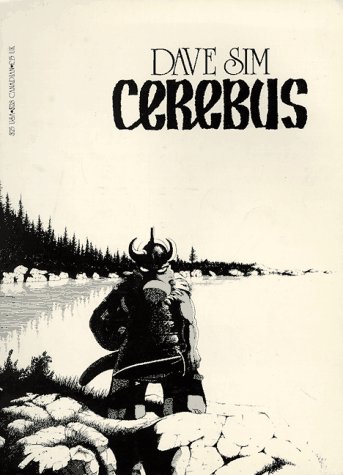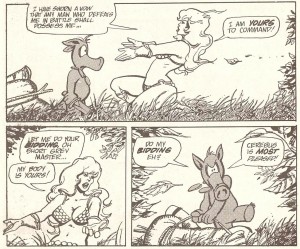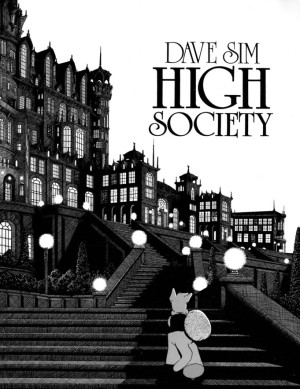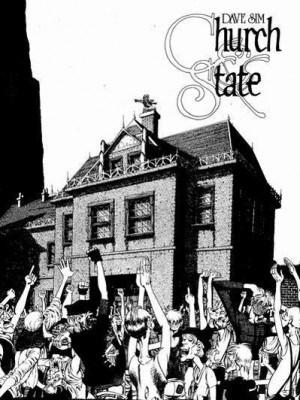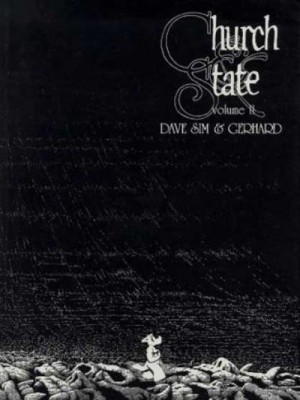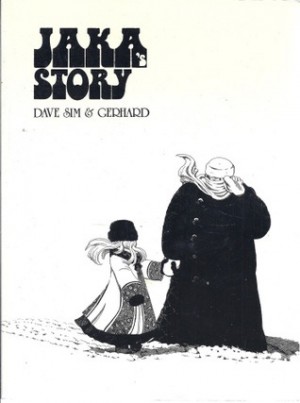Review by Roy Boyd
Dave Sim, writer, artist, and perhaps more importantly, publisher, had vowed from the outset to keep all of Cerebus, the comic, in print and always available. This had initially been made possible by reprinting four comic’s worth of stories in the six-part Swords of Cerebus series, a format he later abandoned after the success of the ‘phonebook’ collections, so called because they were the size and shape of large phonebooks (the first four are around 500-600 pages, a format that had largely been unexplored in Western comics at the time). Cerebus, though the first book, was actually printed third, after the success of High Society and the first volume of Church and State.
Sim had vowed to produce 156 issues of his comic, a figure that he soon adjusted upwards to 300 issues, or 6,000 pages! That he managed to do just that is testament to just how seriously he took his art. And while later books would divide fans and critics (something Sim made a career out of) there’s no denying that the series, when taken in its entirety, is one of the most impressive achievements in comics.
Cerebus, an aardvark in a world of humans, began life as a shameless pastiche of Robert E. Howard’s Conan stories, drawn in a style that’s just as blatantly trying to be Barry Windsor-Smith. At least for the first half of this book, Sim adopts the overblown, breathless style of Conan, and most of their plots (animated stone giants, evils wizards, sexy enchantresses, reanimated corpses, giant snakes, smoke monsters and enchanted jewels). Though if one has to borrow from a pulp writer, one could do worse than Howard, who was superior to many of his contemporaries. Unlike later books, which were much longer stories (Church and State runs to 1,200 pages, split over two books) the stories included here are shorter, just one, two or three chapters.
Then we’re introduced to Lord Julius, ruler of Palnu, who looks, sounds and acts exactly like Groucho Marx. This is around the 300-page mark, and everything changes, with Sim rather abruptly abandoning his Conan pastiche in favour of political satire that’s part Marx Brothers and part West Wing.
Lord Julius wasn’t the only character to be based on a real person. Over the course of the series a long list would include Margaret Thatcher, the other Marx Brothers, Mick Jagger and Keith Richards, Schwarzenegger and many more, with Marvel’s stable of superheroes coming in for some affectionate ribbing in the Roach’s many incarnations: Moon Roach, Roach-Hulk, Wolveroach… well, you get the idea.
The artwork, at least initially, is rough, though one has to bear in mind that this was a small press title being produced in the late seventies, a time when people were still rubbing down Letraset lettering and applying dot-tints by hand. The development in the art is plain to see throughout the book, and is just one of the pleasures to be had from reading a creator’s first book. Sim’s own style would quickly mature into one of the most distinctive in comics, and when Gerhard joined him to do backgrounds from Church and State onwards, their work together was often sublime (check out Jaka’s Story).
Robert E. Howard himself quickly discovered that there’s only so much you can do with the tropes of Sword and Sorcery, and it’s clear long before the end of this volume that Sim was ready to stretch his writing and artistic wings with the book that would see his ‘earth-pig’ really take flight, and play a large part in heralding the graphic novel revolution: High Society.
